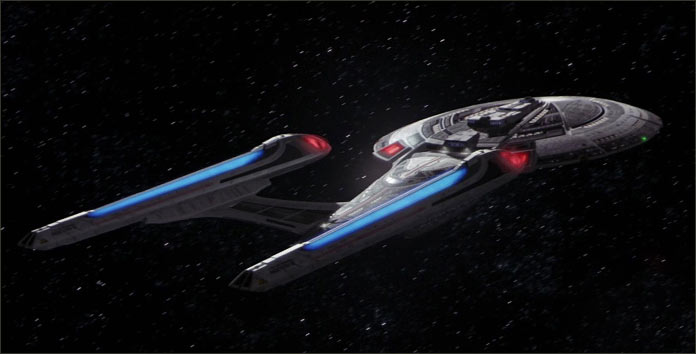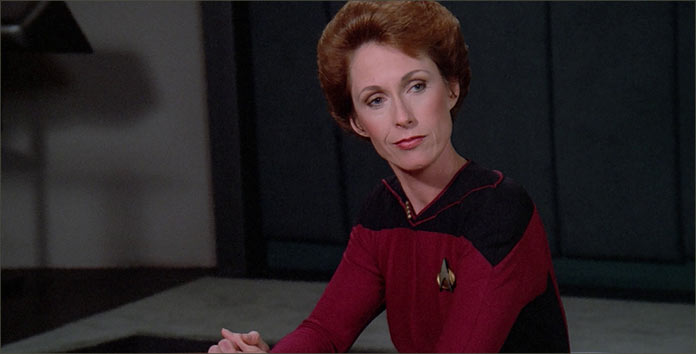Section 31, the covert organization which has operated without accountability in the shadows for more than two centuries, has been exposed.
Throughout the Federation, the rogue group’s agents and leaders are being taken into custody as the sheer scope of its misdeeds comes to light.
Now Starfleet Command must decide the consequences for numerous officers caught up in the scandal—including Admirals William Ross, Edward Jellico, Alynna Nechayev, and Captain Jean-Luc Picard who, along with many others, are implicated in the forced removal of a Federation president.
Meanwhile, deep in the distant, unexplored region of space known as the Odyssean Pass, Picard and the crew of the Starship Enterprise must put aside personal feelings and political concerns as they investigate a massive mysterious spacecraft.
Adrift for centuries in the void, the ship is vital to the survival of an endangered civilization which has spent generations searching for a world to sustain what remains of its people. Complicating matters is a band of marauders who have their own designs on the ancient ship, with only the Enterprise standing in their way….
24th century Star Trek novels are back! This month’s new release, Star Trek: The Next Generation —Available Light, is the first novel set in the post-Star Trek: Nemesis timeframe since March 2018’s Architects of Infinity — and it’s been a long time coming.
It is believed that the drought between Star Trek novel releases, which saw only Kirsten Beyer’s Architects of Infinity novel and four Star Trek: Discovery tales, was a result of Simon & Schuster’s efforts to renew their license with CBS. It appears, with the publishing of Available Light (and a number of additional titles) on the docket for 2019, the drought has now ended and something more akin to the publishing schedule we have gotten used over the last decade and a half has returned.
With one trade-paperback-sized exception. Before we get to discussing Dayton Ward’s fabulous novel, it is probably important to acknowledge up front that the return of Star Trek novels comes with a slightly higher price tag, as Available Light has been published in Discovery-sized trade paperback, as opposed to the smaller mass market paperback sizes most Trek novels have been published in by Pocket Books since the 1979 novelization of Star Trek: The Motion Picture.
While that might come as a frustrating to book collectors, who are never thrilled when the size of a series of books changes up on them, the shift to trade paperback publishing was probably overdue, and represents a wider move by the industry in recent years towards publishing paper books in the larger size, particularly as the market for e-books has grown.

From a readability stand point, I actually prefer the trade paperback size as larger dimensions make the book easier to hold and the larger print easier to read — or maybe I’m just getting old. I haven’t decided myself whether Available Light will set with the rest of the trade paperbacks, or if I’ll try and make space for it among the rest of the series of books it continues, but what’s most important here is – we have new 24th century stories again!
And what a great way to pick things up where they left off. Dayton Ward returns to continuing the voyages of the USS Enterprise-E, which is on an extended exploration mission of the Odyssean Pass. Ward has done a great job in previous novels – Headlong Flight, Armageddon’s Arrow, and Hearts and Minds – of telling episodic tales of seeking out new worlds and new civilizations, while also carrying story threads over from previous novels that explore other ideas from the pantheon of Star Trek novels.
Available Light is no exception, telling a thrilling action adventure tale as the Enterprise renders assistance to a large starship they encounter in deep space – one that appears, at first glance, not to have a crew. It is revealed that the starship the Enterprise has encountered, the Osijemal, is a generational ship of the Nejamri, a race who faced extinction on their homeworld and so set out for the stars.

While making first contact and rendering assistance, the Enterprise must also deal with scavengers from a different race, the Torrekmat, who are trying to lay claim to salvage the seemingly abandoned Osijemal. Ward tells a great story, contained within the narrative of the novel and provides the kind of traditional episodic Star Trek adventure that many fans are hungry for.
In the two years since his last Next Generation novel, Ward has not lost the voices of these characters either. He consistently nails the characteristics of Picard, Crusher, La Forge, and Worf, as well as continues to expand upon and provide distinctive voices for the Enterprise’s new crewmembers that have been introduced in the novels, most prominently the first contact specialist T’Ryssa Chen.
If rendering assistance to the Nejamri is the A-story of the novel, following up on the fallout from the events of David Mack’s Section 31: Control is the B-story. Control, which likely served as the inspiration for the villain in Star Trek: Discovery’s second season, ended with Section 31 destroyed, the artificial intelligence program known as Uraei defeated, and the secrets of the clandestine organization laid bare for everyone in the Federation to read.
As a result of the release of the Section 31 files, Picard’s association in a coup to stop former Federation President Min Zife from instigating a war from the Klingon’s was exposed. As admirals and notable Federation citizens are being rounded up and arrested – including Admirals William Ross, Alynna Nechayev, Tujiro Nakamura – for their association with Section 31, the political class in the Federation grapple with what to do about the Enterprise’s captain.

It is a testament to the work of both the editors and the authors of the Star Trek line that repercussions of events from the novels A Time to Kill and A Time to Heal by David Mack, first published in 2004, are being explored 15 years later. What a treat for those book fans like myself who have been reading along since that time, to have these story threads continue and be paid off down the line.
Regardless of what happens to the continuity that has been developed by the Star Trek novels as a result of televised Star Trek returning to a post-Voyager timeframe in the still-untitled Picard show, we have been blessed as fans over nearly two decades that the editors and authors have cared as much about this property as we have, and have given us some truly compelling stories to enjoy throughout all that time.
And in some cases, the books have given us more interesting concepts that are better executed upon than even televised Star Trek itself. Indeed, with the decision to continue the story about the fallout from the destruction of the Uraei/Control program, it is tough not to draw parallels with Star Trek: Discovery’s second season and the depiction of Control that we got there.
Frankly, the book depiction is the superior one. In Discovery Season 2, Control is set up as a villain with a mission, but without much of a motive. The Control that is depicted in the books is so much deeper, and more fundamentally interesting than Discovery’s Control. Uraei was a computer program that guided the creation of the Federation itself, and asks foundationally-important questions about the extent to which the progress experienced by humanity in building the Federation was as a result of human growth, or the interference of an artificial intelligence.

It’s such a challenging idea – Did we create paradise, or was it created for us? – that it sits among the most interesting questions that have been asked anywhere in Star Trek. Ever. Discovery’s execution was fine, but ultimately stripped the idea of anything that made it uniquely Star Trek. I am so pleased that the novels are continuing to examine the fallout from Uraei, and have the characters ask the same set of questions the reader is encouraged to – are we responsible for the Federation, or was it given to us?
While the A-story is resolved and the Nejamri are sent on their way, the B-story of the novel ends on a cliffhanger, with the Enterprise and Captain Picard returning to Earth to face the potential consequences of his actions. That story will be picked up again in October by David Mack, returning to writing The Next Generation cast in Collateral Damage. I can’t wait!
Overall, Dayton Ward does a great job of telling us a tale of exploration aboard the Enterprise, while balancing the Earth-based plot following the Federation’s Attorney General, Phillipa Louvois (from “The Measure of a Man”) as she struggles to deal with the fallout from the unmasking of Section 31.

As a huge sucker for seeking out new worlds, and for anything touching upon Federation politics, Star Trek: The Next Generation — Available Light totally worked for me. I am excited to see where this story is heading, and I will be very interested to see if they take any opportunities to tie into the forthcoming Picard show.
Discovery’s second season proved that the current Star Trek writers and producers have no qualms about adapting concepts or ideas from the books to television (Control and naming Number One as Una being the best examples,) and so perhaps something similar is forthcoming for the 24th century. We’ll have to wait and see!
